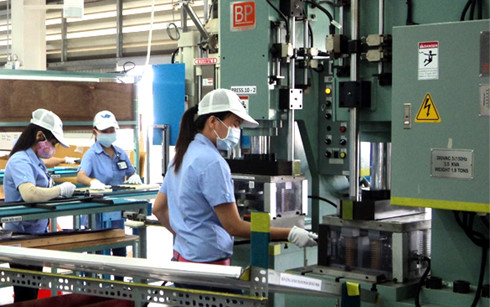Behind Vietnam’s strong economic growth and widespread national development, there is an engine of increasing foreign direct investment.

Its big cities, Ho Chi Minh City and Hanoi, are at the forefront of the transformation, as more people flock there and new high rise buildings change the skylines.
Foreign investors are taking note: They ploughed an estimated US$15.8 billion into the country in 2016-setting a new record. And Vietnam’s policy changes are encouraging them to do so.
The country relaxed its foreign ownership rules for real estate in 2015. Vietnam witnessed strong growth in foreign direct investment (FDI) in 2016. This can be attributed to a strong economy backed by political stability and relatively low labour costs when compared to the region.
Manufacturing dominates FDI, accounting for 64%, but 7% of total FDI is attributed to real estate. The sector attracted US$1.53 billion in newly registered capital in 2016 with 59 newly registered projects.
Changing ambitions, shifting gears
Vietnam’s upward trajectory looks set to continue, despite the slowdown affecting other Asian countries.
It posted GDP growth of 6.2% last year-a figure which is forecast to rise to 6.7% this year amid growing affluence and higher consumption levels of the country’s middle-class, who are developing a taste for foreign brands such as Starbucks and Louis Vuitton.
Vietnam’s middle-class is expected to double to 33 million people by 2020. Ho Chi Minh City is home to Southeast Asia’s fastest-growing middle-class, according to Boston Consulting Group.
Vietnam is projected to continue to be an optimistic, prospective destination for investment, attracting higher growth in FDI inflows.
According to the Ministry of Planning and Investment’s Foreign Investment Agency, in January 2017 Vietnam welcomed US$1.42 billion FDI, an increase of 6.6% year-on-year. The implemented capital was recorded at US$850 million, rising 6.3% compared with the same period in 2016, despite changes in trade agreements.
In terms of economic structure, most of the total foreign capital is poured into both the processing and manufacturing sector and real estate sector, bringing in US$1.01 billion and US$297.36 million at the beginning of 2017, respectively.
These sectors are expected to remain significant attractors of investment activity in the months to come.
Recently, a large number of multinational companies have entered Vietnam by virtue of the country’s favourable business costs, which are highly competitive when compared with other countries in the region.
Most FDI companies from Asian countries are tending to gravitate towards the potential economic hubs of Binh Duong, Dong Nai, Ba Ria-Vung Tau and Haiphong.
Investment into these hubs has been on the rise following the success of Ho Chi Minh City and Hanoi.
Furthermore, the emerging wave of dynamic entrepreneurs and innovation in technology are major drivers in attracting foreign investment expansion in the outsourcing industry, and in lifting the Vietnamese economy as well.
The country has also benefited from the return of overseas Vietnamese, known as Viet Kieu, who are becoming major players in spurring Vietnam’s economy and growing its thriving startup scene in Ho Chi Minh City and Hanoi.
Such strong economic and population growth factors have led to both cities making the top 10 of JLL’s latest Cities Momentum Index, with Ho Chi Minh City in second place and Hanoi in eighth.
Securing longer-term development
However, both Hanoi and Ho Chi Minh City still have work to do to secure their longer-term positions. The transition towards technology-based high-value activities remains at an early stage. Congestion and pollution remain serious impediments to quality of life and increasing productivity.
A lack of strong higher-education institutions and technology skills may slow the transition towards a knowledge-based economy.
Such challenges will require planning and investment to overcome, yet are far from insurmountable. Indeed, with the government taking concrete steps to liberalise the business environment and create the right conditions for future growth, the country could well be on its way to becoming another success story in Southeast Asia.
Looking forward a few years, the flow of investment into the country will constantly outperform past levels, thanks to energetic demographics with more than 70% of the total population of working age and well-trained.
The business environment is stable and has improved, and the strong demand of the growing middle-and upper-classes, which is forecast to reach the fastest growth rate in Southeast Asia over the 2016-2020 period, can only be beneficial.
Real estate boom
Demand is increasing for office, retail, and hotel stock around the country. In Ho Chi Minh City, the country’s tallest building, the Vincom Landmark 81, is under construction.
Meanwhile, the Thu Thiem New Urban Area, a 657ha site east of the Saigon River, is ear-marked to be the new central financial district.
And last year, Takashimaya opened its first department store in Vietnam, within Saigon Centre in Ho Chi Minh City, a mixed-use development by Keppel Land from Singapore.
In Hanoi, the office sector is also seeing high levels of development, according to JLL research, while a new urban living project, Starlake Tay Ho Tay, is being constructed by the Republic of Korea conglomerate Daewoo Condotels and villas are also being built in secondary cities such as Danang to woo investors in the second-home market.
Vietnam’s burgeoning tourism industry, which welcomed 10 million visitors last year, is driving hotel developments. The Hoi An South Integrated Resort is currently being constructed, with its first phase to be completed in 2019.
Meanwhile, Halong Bay got its first five-star property, Wyndham Legend Halong Bay, last June.
There has been a lot of attention towards major tourist locations such as Danang, Nha Trang, and Phu Quoc in the last two years.
Industrial real estate is also enjoying a boost. Industrial parks in the north, south, and central regions are witnessing strong activity.
For instance, Long An province in southern Vietnam is experiencing strong demand for ready-built factories and industrial land. Binh Duong and nearby provinces are witnessing developments of eco-industrial parks and modern townships, invested mainly by Japanese investors.
VIR
Stephen Wyatt